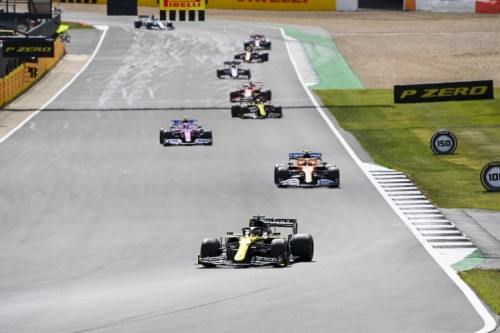Pirelli to review minimum F1 tyre pressures after Silverstone failures
 Silverstone on Sunday (Photo: Pirelli)
Silverstone on Sunday (Photo: Pirelli)
Formula 1’s exclusive tyre supplier Pirelli has concluded its initial analysis on a number of tyres run at the British Grand Prix. The tyre supplier said it has identified the cause of the tyre failures on both Mercedes and the McLaren of Carlos Sainz in Sunday’s race. A combination of the long stints the P Zero White (C1) was forced to complete and the “biggest forces” on F1 tyres ever meant the tyres were “placed under maximum stress” for a long period. The resultant wear on the tyres meant that the tyres were less protected from the extreme forces by the end of the race. While Pirelli plans to continue with its plan to supply softer compounds at the second Silverstone meeting, it said it would review the usage prescription for its F1 tyres, increasing the minimum tyre pressures to reduce structural stress.
Pirelli’s statement on the tyre failures read: “The key reason is down to a set of individual race circumstances that led to an extremely long use of the second set of tyres. The second safety car period prompted nearly all the teams to anticipate their planned pit stop and so carry out a particularly long final stint: around 40 laps, which is more than three-quarters the total race length on one of the most demanding tracks of the calendar.
“Combined with the notably increased pace of the 2020 Formula 1 cars (pole position was 1.2 seconds faster compared to 2019) this made the final laps of the British Grand Prix especially tough, as a consequence of the biggest forces ever seen on tyres generated by the fastest Formula 1 cars in history.
“The overall result was the most challenging operating conditions for tyres. These led to the front-left tyre (which is well-known for working hardest at Silverstone) being placed under maximum stress after a very high number of laps, with the resulting high wear meaning that it was less protected from the extreme forces in play.
“For the second race at Silverstone this weekend, Pirelli confirms the nominated compounds: C2, C3, and C4, being one step softer than those seen at the last GP.
“Also the usage prescription will be reviewed, increasing the minimum tyre pressures to reduce the stress on the construction.”

 Goodyear
Goodyear
Comments